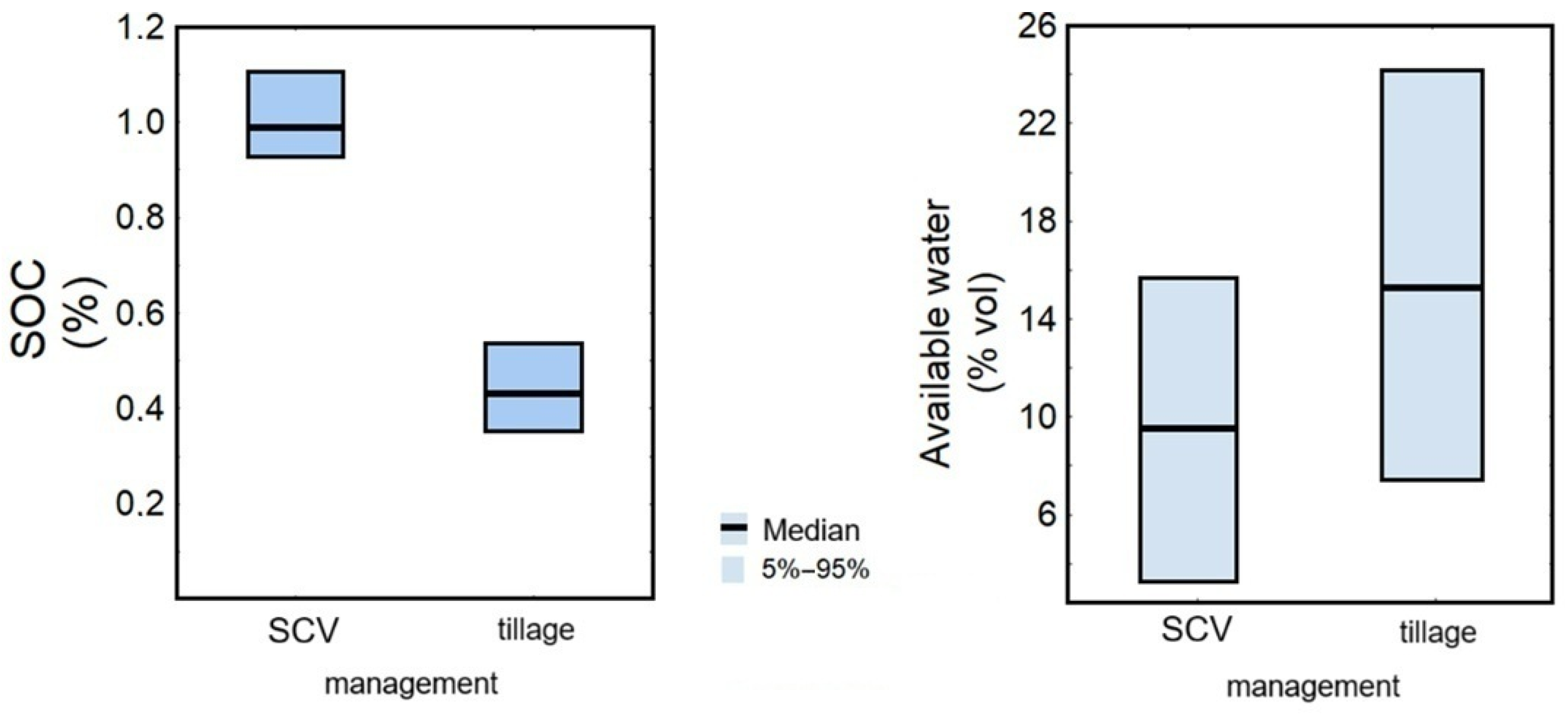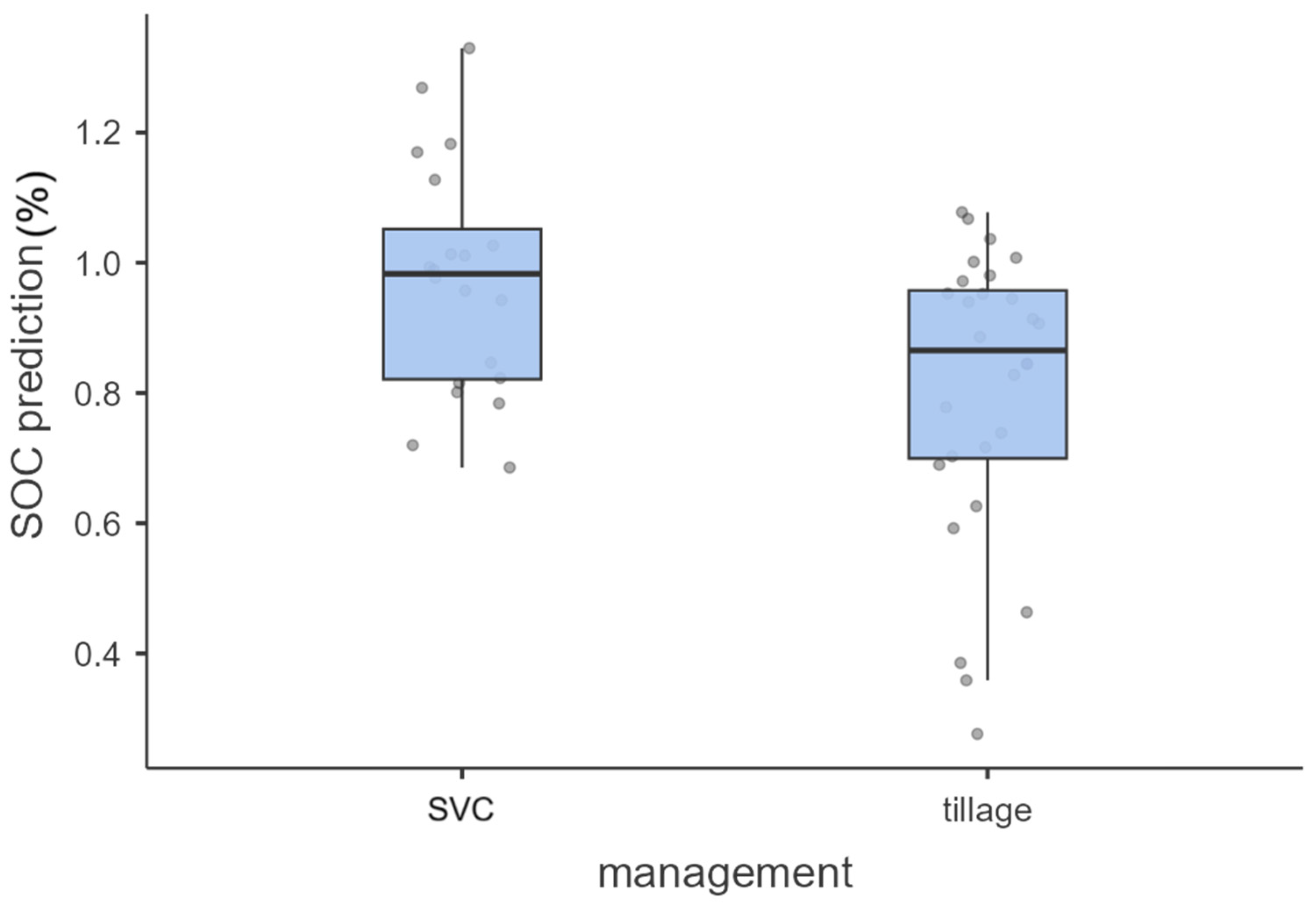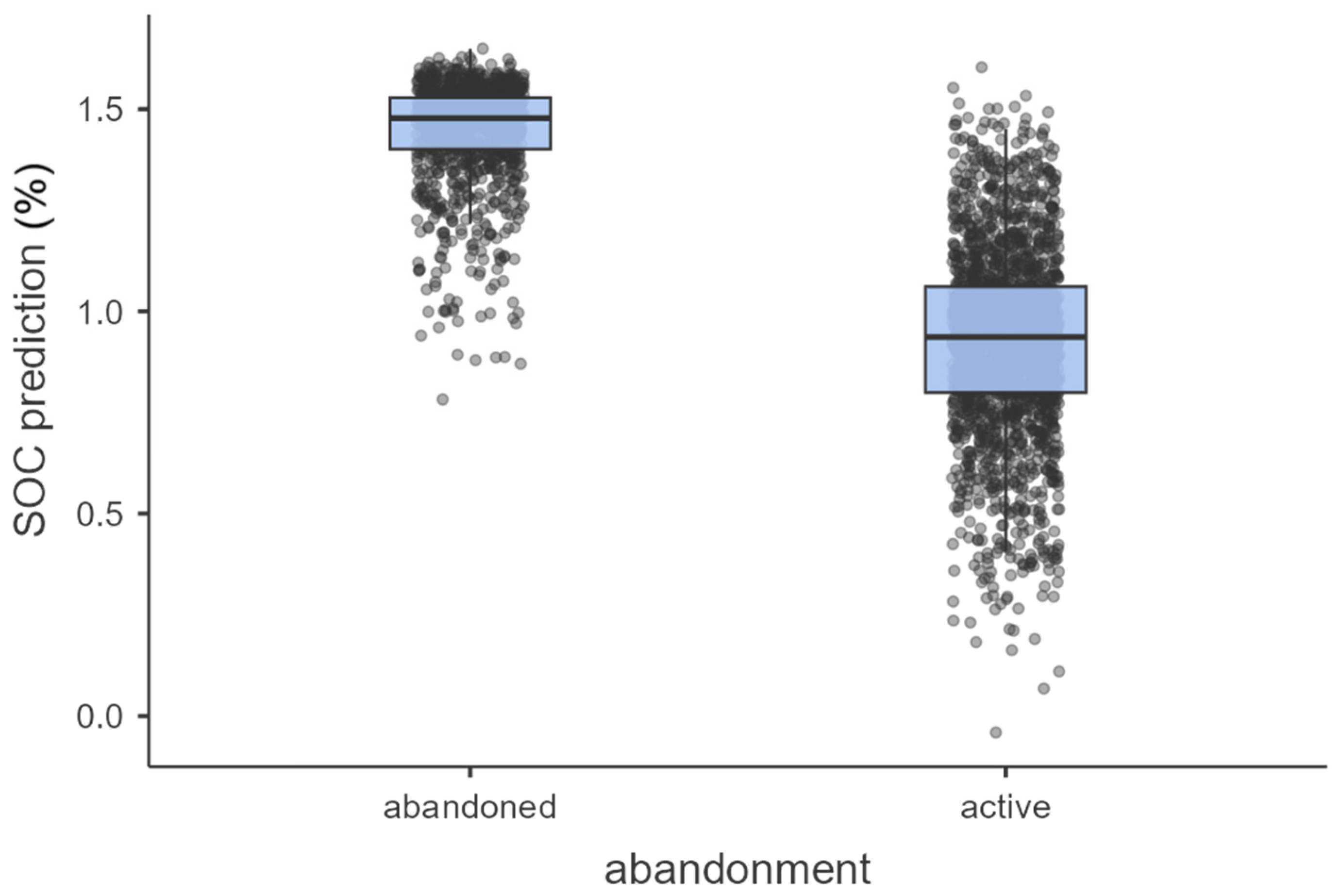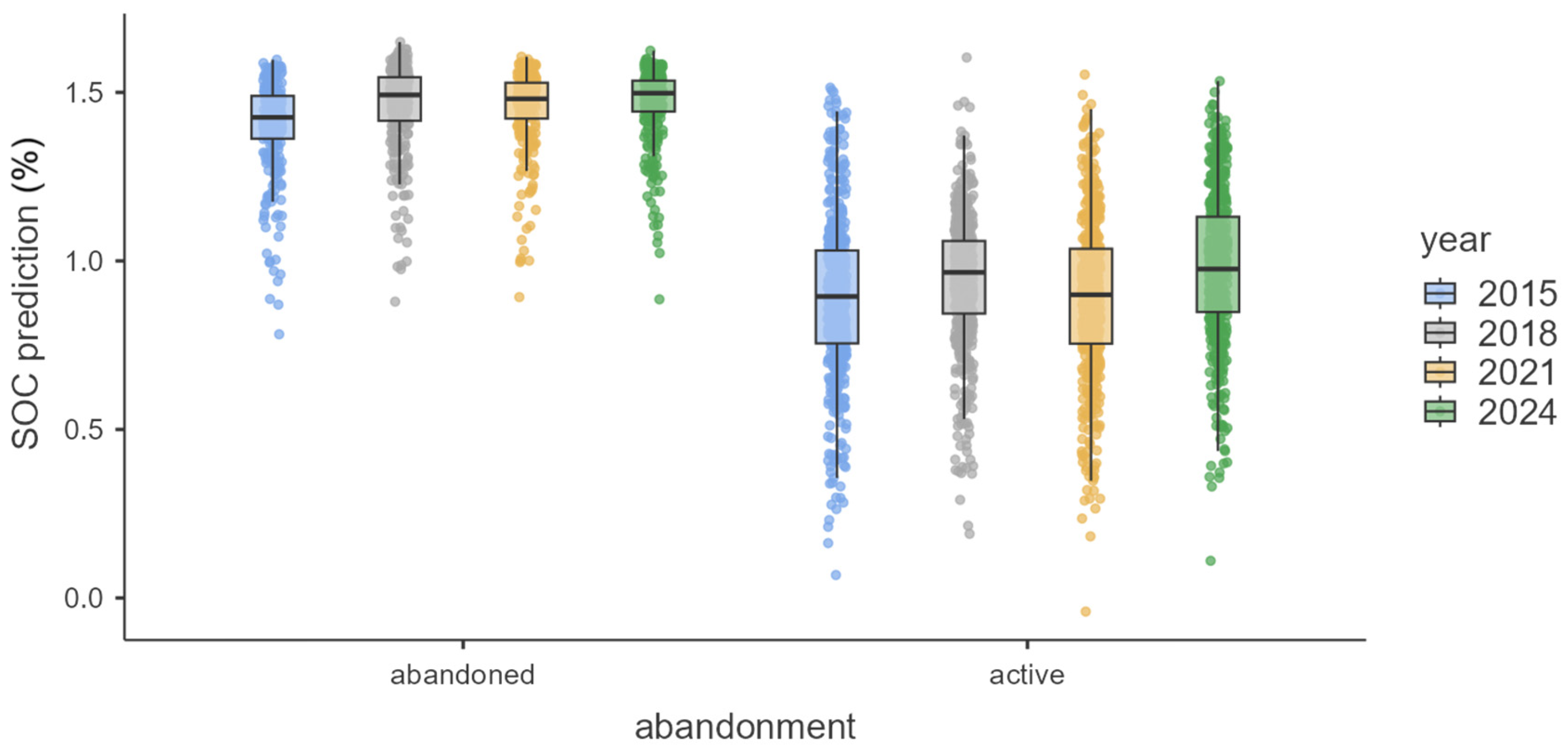Soil Management and Machine Learning Abandonment Detection in Mediterranean Olive Groves Under Drought: A Case Study from Central Spain
Abstract
1. Introduction
2. Materials and Methods
2.1. Study Area
2.2. Ground and Vegetation Data
2.3. Remote Sensing Data
2.4. Abandonment Identification
3. Results
3.1. Ground Data
3.2. Remote Sensing Results
3.3. Abandonment Identification Results
4. Discussion
5. Conclusions
Author Contributions
Funding
Institutional Review Board Statement
Informed Consent Statement
Data Availability Statement
Acknowledgments
Conflicts of Interest
References
- Bonfante, A.; Monaco, E.; Langella, G.; Mercogliano, P.; Bucchignani, E.; Manna, P.; Terribile, F. A Dynamic Viticultural Zoning to Explore the Resilience of Terroir Concept under Climate Change. Sci. Total Environ. 2018, 624, 294–308. [Google Scholar] [CrossRef] [PubMed]
- Caubel, J.; García De Cortázar-Atauri, I.; Launay, M.; De Noblet-Ducoudré, N.; Huard, F.; Bertuzzi, P.; Graux, A.-I. Broadening the Scope for Ecoclimatic Indicators to Assess Crop Climate Suitability According to Ecophysiological, Technical and Quality Criteria. Agric. For. Meteorol. 2015, 207, 94–106. [Google Scholar] [CrossRef]
- Malanson, G.P.; Nelson, E.L.; Zimmerman, D.L.; Fagre, D.B. Alpine Plant Community Diversity in Species–Area Relations at Fine Scale. Arct. Antarct. Alp. Res. 2020, 52, 41–46. [Google Scholar] [CrossRef]
- White, F.J. Two Decades of Climate Change Alters Seed Longevity in an Alpine Herb: Implications for Ex Situ Seed Conservation. Alp. Bot. 2023, 133, 11–20. [Google Scholar] [CrossRef]
- Kikstra, J.S.; Nicholls, Z.R.J.; Smith, C.J.; Lewis, J.; Lamboll, R.D.; Byers, E.; Sandstad, M.; Meinshausen, M.; Gidden, M.J.; Rogelj, J.; et al. The IPCC Sixth Assessment Report WGIII Climate Assessment of Mitigation Pathways: From Emissions to Global Temperatures. Geosci. Model Dev. 2022, 15, 9075–9109. [Google Scholar] [CrossRef]
- Rocourt, J.; BenEmbarek, P.; Toyofuku, H.; Schlundt, J. Quantitative Risk Assessment of Listeria monocytogenes in Ready-to-eat Foods: The FAO/WHO Approach. FEMS Immunol. Med. Microbiol. 2003, 35, 263–267. [Google Scholar] [CrossRef]
- Zhang, R.; Qi, J.; Leng, S.; Wang, Q. Long-Term Vegetation Phenology Changes and Responses to Preseason Temperature and Precipitation in Northern China. Remote Sens. 2022, 14, 1396. [Google Scholar] [CrossRef]
- Ruiz-Colmenero, M.; Bienes, R.; Marques, M.J. Soil and Water Conservation Dilemmas Associated with the Use of Green Cover in Steep Vineyards. Soil Tillage Res. 2011, 117, 211–223. [Google Scholar] [CrossRef]
- Bommarco, R.; Kleijn, D.; Potts, S.G. Ecological Intensification: Harnessing Ecosystem Services for Food Security. Trends Ecol. Evol. 2013, 28, 230–238. [Google Scholar] [CrossRef]
- Kruidhof, H.M.; Bastiaans, L.; Kropff, M.J. Ecological Weed Management by Cover Cropping: Effects on Weed Growth in Autumn and Weed Establishment in Spring. Weed Res. 2008, 48, 492–502. [Google Scholar] [CrossRef]
- Kopta, T.; Pokluda, R.; Psota, V. Attractiveness of Flowering Plants for Natural Enemies. Hortic. Sci. 2012, 39, 89–96. [Google Scholar] [CrossRef]
- Thomson, L.J.; Hoffmann, A.A. Spatial Scale of Benefits from Adjacent Woody Vegetation on Natural Enemies within Vineyards. Biol. Control 2013, 64, 57–65. [Google Scholar] [CrossRef]
- Miles, A.; Wilson, H.; Altieri, M.; Nicholls, C. Habitat Diversity at the Field and Landscape Level: Conservation Biological Control Research in California Viticulture. In Arthropod Management in Vineyards; Bostanian, N.J., Vincent, C., Isaacs, R., Eds.; Springer: Dordrecht, The Netherlands, 2012; pp. 159–189. ISBN 978-94-007-4031-0. [Google Scholar]
- Fiera, C.; Ulrich, W.; Popescu, D.; Bunea, C.-I.; Manu, M.; Nae, I.; Stan, M.; Markó, B.; Urák, I.; Giurginca, A.; et al. Effects of Vineyard Inter-Row Management on the Diversity and Abundance of Plants and Surface-Dwelling Invertebrates in Central Romania. J. Insect Conserv. 2020, 24, 175–185. [Google Scholar] [CrossRef]
- Leite, D.; Teixeira, I.; Morais, R.; Sousa, J.J.; Cunha, A. Comparative Analysis of CNNs and Vision Transformers for Automatic Classification of Abandonment in Douro’s Vineyard Parcels. Remote Sens. 2024, 16, 4581. [Google Scholar] [CrossRef]
- Teixeira, I.; Sousa, J.J.; Cunha, A. Automatic Classification of Abandonment in Douro’s Vineyard Parcels. Procedia Comput. Sci. 2024, 239, 2038–2047. [Google Scholar] [CrossRef]
- Badgujar, C.M.; Poulose, A.; Gan, H. Agricultural Object Detection with You Only Look Once (YOLO) Algorithm: A Bibliometric and Systematic Literature Review. Comput. Electron. Agric. 2024, 223, 109090. [Google Scholar] [CrossRef]
- González-Leonardo, M.; López-Gay, A.; Recaño, J. Brain Drain and the Second Wave of Depopulation; Centre d’Estudis Demogràfics: Bellaterra, Spain, 2019. [Google Scholar]
- Gallardo, M.; Fernández-Portela, J.; Cocero, D.; Vilar, L. Land Use and Land Cover Changes in Depopulated Areas of Mediterranean Europe: A Case Study in Two Inland Provinces of Spain. Land 2023, 12, 1967. [Google Scholar] [CrossRef]
- Lloret, F.; Escudero, A.; Lloret, J.; Valladares, F. An Ecological Perspective for Analysing Rural Depopulation and Abandonment. People Nat. 2024, 6, 490–506. [Google Scholar] [CrossRef]
- Santos, J.L. Desploblación y periurbanización en la Alcarria. In Anales de Geografía de la Universidad Complutense; Ediciones Complutense: Madrid, Spain, 2024. [Google Scholar]
- Alonso, J.-J.G.-A.; Martínez, E.-D.G. Vegetation/Land Cover of a UTM-Hectad in Utande (La Alcarria, Central Spain). J. Maps 2023, 19, 2139202. [Google Scholar] [CrossRef]
- Gholizadeh, A.; Žižala, D.; Saberioon, M.; Borůvka, L. Soil Organic Carbon and Texture Retrieving and Mapping Using Proximal, Airborne and Sentinel-2 Spectral Imaging. Remote Sens. Environ. 2018, 218, 89–103. [Google Scholar] [CrossRef]
- Escadafal, R. Remote Sensing of Arid Soil Surface Color with Landsat Thematic Mapper. Adv. Space Res. 1989, 9, 159–163. [Google Scholar] [CrossRef]
- Todd, S.W.; Hoffer, R.M. Responses of Spectral Indices to Variations in Vegetation Cover and Soil Background. Photogramm. Eng. Remote Sens. 1998, 64, 915–922. [Google Scholar]
- Kunkel, V.R.; Wells, T.; Hancock, G.R. Modelling Soil Organic Carbon Using Vegetation Indices across Large Catchments in Eastern Australia. Sci. Total Environ. 2022, 817, 152690. [Google Scholar] [CrossRef]
- AEMET (Agencia Estatal de Meteorología). Valores Climatológicos Normales. Estación El Serranillo (3168C), Periodo 1981–2010. Available online: https://www.aemet.es/es/serviciosclimaticos/datosclimatologicos/valoresclimatologicos (accessed on 17 July 2025).
- Carter, M.R.; Gregorich, E.G. Soil Sampling and Methods of Analysis, 2nd ed.; CRC Press: Boca Raton, FL, USA, 2008; ISBN 978-0-8493-3586-0. [Google Scholar]
- IUSS. Working Group WRB World Reference Base for Soil Resources. International Soil Classification System for Naming Soils and Creating Legends for Soil Maps, 4th ed.; International Union of Soil Sciences (IUSS): Vienna, Austria, 2022. [Google Scholar]
- Ballesta, R.J.; Pérez-de-los-Reyes, C.; Amorós, A.; Bravo, S.; Navarro, F.J.G. Edafodiversidad en viñedos de Castilla-La Mancha, España. E3S Web Conf. 2018, 50, 01026. [Google Scholar] [CrossRef]
- A Protocol for Measurement, Monitoring, Reporting and Verification of Soil Organic Carbon in Agricultural Landscapes: GSOC MRV Protocol; Food and Agriculture Organization of the United Nations: Rome, Italy, 2020; ISBN 978-92-5-133126-2.
- Gowing, C. Standard Operating Procedure for Soil Calcium Carbonate Equivalent—Volumetric Calcimeter Method; Food and Agriculture Organization: Rome, Italy, 2021. [Google Scholar]
- Bouyoucos, G.J. Hydrometer Method Improved for Making Particle Size Analyses of Soils. Agron. J. 1962, 54, 464–465. [Google Scholar] [CrossRef]
- Walkley, A.; Black, I.A. An Examination of the Degtjareff Method for Determining Soil Organic Matter, and a Proposed Modification of the Chromic Acid Titration Method. Soil Sci. 1934, 37, 29–38. [Google Scholar] [CrossRef]
- Standard Operating Procedure for Soil Bulk Density, Cylinder Method; FAO: Rome, Italy, 2023.
- Richards, L.A. A Pressure-Membrane Extraction Apparatus for Soil Solution. Soil Sci. 1941, 51, 377–386. [Google Scholar] [CrossRef]
- Cagney, J.; Cox, S.E.; Booth, D.T. Comparison of Point Intercept and Image Analysis for Monitoring Rangeland Transects. Rangel. Ecol. Manag. 2011, 64, 309–315. [Google Scholar] [CrossRef]
- Booth, D.T.; Cox, S.E.; Berryman, R.D. Point Sampling Digital Imagery with ‘Samplepoint’. Environ. Monit. Assess. 2006, 123, 97–108. [Google Scholar] [CrossRef]
- Hulvey, K.B.; Thomas, K.; Thacker, E. A Comparison of Two Herbaceous Cover Sampling Methods to Assess Ecosystem Services in High-Shrub Rangelands: Photography-Based Grid Point Intercept (GPI) Versus Quadrat Sampling. Rangelands 2018, 40, 152–159. [Google Scholar] [CrossRef]
- USDA Agricultural Research Service products and services. SamplePoint; USDA Agricultural Research Service: Washington, DC, USA, 2009. [Google Scholar]
- QGIS Association. QGIS Geographic Information System; QGIS Association: Gruthe, Switzerland, 2024. [Google Scholar]
- O.A. Centro Nacional de Información Geográfica; Fondo Español de Garantía Agraria; Principado de Asturias, Comunidad Autónoma de Cantabría; Comunidad de Madrid; Comunidad Autónoma de Galicia; Comunidad Foral de Navarra; Comunidad Autónoma de La Rioja y Eusko Jaurltaritza/Gobierno Vasco PNOA 2023 CC-BY 4.0 Instituto Geográfico Nacional 2023. Available online: https://centrodedescargas.cnig.es/ (accessed on 2 April 2025).
- Copernicus Sentinel Data. Available online: https://browser.dataspace.copernicus.eu/ (accessed on 2 April 2025).
- StatSoft, Inc. STATISTICA; Data Analysis Software System; StatSoft, Inc.: Tulsa, OK, USA, 2011. [Google Scholar]
- R Core Team. R: A Language and Environment for Statistical Computing; R Core Team: Vienna, Austria, 2024. [Google Scholar]
- The jamovi project Jamovi; Jamovi Team: Sydney, Austria, 2024.
- Anwar, S.; Marchese, G.; Toffanin, C.; Vaglia, V. Vineyard condition detection method using Google Earth Images and the YOLOv8 model in Northern Italy. In Proceedings of the EGU General Assembly 2025, Vienna, Austria, 27 April–2 May 2025. EGU25-981. [Google Scholar] [CrossRef]
- Roboflow: Computer Vision and Dataset Management Platform; Roboflow Inc.: Des Moines, IA, USA, 2024; Available online: https://roboflow.com/ (accessed on 6 June 2025).
- Ultralytics. YOLOv12: Real-Time Object Detection; Ultralytics: London, UK, 2024; Available online: https://github.com/ultralytics/ (accessed on 23 June 2025).
- Lal, R. Soil Carbon Sequestration to Mitigate Climate Change. Geoderma 2004, 123, 1–22. [Google Scholar] [CrossRef]
- Grilli, E. Critical Range of Soil Organic Carbon in Southern Europe Lands under Desertification Risk. J. Environ. Manag. 2021, 287, 112285. [Google Scholar] [CrossRef] [PubMed]
- Calvo De Anta, R.; Luís, E.; Febrero-Bande, M.; Galiñanes, J.; Macías, F.; Ortíz, R.; Casás, F. Soil Organic Carbon in Peninsular Spain: Influence of Environmental Factors and Spatial Distribution. Geoderma 2020, 370, 114365. [Google Scholar] [CrossRef]
- Angelopoulou, T.; Tziolas, N.; Balafoutis, A.; Zalidis, G.; Bochtis, D. Remote Sensing Techniques for Soil Organic Carbon Estimation: A Review. Remote Sens. 2019, 11, 676. [Google Scholar] [CrossRef]
- van Wesemael, B.; Abdelbaki, A.; Ben-Dor, E.; Chabrillat, S. A European Soil Organic Carbon Monitoring System Leveraging Sentinel 2 Imagery and the LUCAS Soil Data Base. Geoderma 2024, 452, 117113. [Google Scholar] [CrossRef]
- Muñoz-Rojas, M.; Jordán, A.; Zavala, L.M.; De la Rosa, D.; Abd-Elmabod, S.K.; Anaya-Romero, M. Organic Carbon Stocks in Mediterranean Soil Types under Different Land Uses (Southern Spain). Solid Earth 2012, 3, 375–386. [Google Scholar] [CrossRef]
- Wang, L.; Li, Z.; Wang, D.; Liao, S.; Nie, X.; Liu, Y. Factors Controlling Soil Organic Carbon with Depth at the Basin Scale. Catena 2022, 217, 106478. [Google Scholar] [CrossRef]
- Stoner, E.R.; Baumgardner, M.F. Characteristic Variations in Reflectance of Surface Soils. Soil Sci. Soc. Am. J. 1981, 45, 1161–1165. [Google Scholar] [CrossRef]
- Li, T.; Cui, L.; Kuhnert, M.; McLaren, T.I.; Pandey, R.; Liu, H.; Wang, W.; Xu, Z.; Xia, A.; Dalal, R.C.; et al. A Comprehensive Review of Soil Organic Carbon Estimates: Integrating Remote Sensing and Machine Learning Technologies. J. Soils Sediments 2024, 24, 3556–3571. [Google Scholar] [CrossRef]
- Van Wesemael, B.; Chabrillat, S.; Sanz Dias, A.; Berger, M.; Szantoi, Z. Remote Sensing for Soil Organic Carbon Mapping and Monitoring. Remote Sens. 2023, 15, 3464. [Google Scholar] [CrossRef]
- Forkuor, G. Landsat-8 vs. Sentinel-2: Examining the Added Value of Sentinel-2′s Red-Edge Bands to Land-Use and l. GIScience Remote Sens. 2018, 55, 331–354. [Google Scholar] [CrossRef]
- Yang, L. Improving Prediction of Soil Organic Carbon Content in Croplands Using Phenological Parameters Extracted from NDVI Time Series Data. Soil Tillage Res. 2020, 196, 104465. [Google Scholar] [CrossRef]
- Fan, B. Soil Micro-Climate Variation in Relation to Slope Aspect, Position, and Curvature in a Forested Catchment. Agric. For. Meteorol. 2020, 290, 107999. [Google Scholar] [CrossRef]
- Seyfried, M.; Flerchinger, G.; Bryden, S.; Link, T.; Marks, D.; McNamara, J. Slope and Aspect Controls on Soil Climate: Field Documentation and Implications for Large-scale Simulation of Critical Zone Processes. Vadose Zone J. 2021, 20, e20158. [Google Scholar] [CrossRef]
- Poeplau, C.; Don, A. Sensitivity of Soil Organic Carbon Stocks and Fractions to Different Land-Use Changes across Europe. Geoderma 2013, 192, 189–201. [Google Scholar] [CrossRef]
- Estel, S.; Kuemmerle, T.; Alcántara, C.; Levers, C.; Prishchepov, A.; Hostert, P. Mapping Farmland Abandonment and Recultivation across Europe Using MODIS NDVI Time Series. Remote Sens. Environ. 2015, 163, 312–325. [Google Scholar] [CrossRef]
- Bell, S.M. Soil Organic Carbon Accumulation Rates on Mediterranean Abandoned Agricultural Lands. Sci. Total Environ. 2021, 759, 143535. [Google Scholar] [CrossRef]
- Yin, H. Mapping Agricultural Land Abandonment from Spatial and Temporal Segmentation of Landsat Time Series. Remote Sens. Environ. 2018, 210, 12–24. [Google Scholar] [CrossRef]
- Sapkota, R.; Meng, Z.; Churuvija, M.; Du, X.; Ma, Z.; Karkee, M. Comprehensive Performance Evaluation of YOLOv12, YOLO11, YOLOv10, YOLOv9 and YOLOv8 on Detecting and Counting Fruitlet in Complex Orchard Environments. arXiv 2025, arXiv:2407.12040. [Google Scholar]
- Marchese, G.; Herranz-Luque, J.E.; Anwar, S.; Vaglia, V.; Toffanin, C.; Moreno-Delafuente, A.; Sastre, B.; Marques, M.J. Data deposit and Images Article Title “Soil Management and Abandonment Detection in Mediterranean Olive Groves under Climate Stress: A Case Study from Central Spain”; Zenodo: Geneva, Switzerland, 2025. [Google Scholar] [CrossRef]







| Variables | Management | Mean (Std) | Q-25 | Median | Q-75 | K-W Test |
|---|---|---|---|---|---|---|
| Soil pH | CC | 8.24 (0.03) | 8.22 | 8.24 | 8.27 | * |
| TILL | 8.47 (0.04) | 8.44 | 8.46 | 8.52 | ||
| CaCO3 (%) | CC | 49.9 (3.1) | 47.7 | 48.5 | 53.4 | * |
| TILL | 62.1 (2.8) | 58.9 | 63.6 | 63.8 | ||
| Bulk density (Mg/m3) | CC | 1.44 (0.16) | 1.25 | 1.53 | 1.54 | |
| TILL | 1.31 (0.18) | 1.14 | 1.31 | 1.49 | ||
| Sand (%) | CC | 48 (13) | 40 | 42 | 64 | |
| TILL | 41 (3) | 39 | 40 | 45 | ||
| Silt (%) | CC | 25 (5) | 20 | 25 | 30 | * |
| TILL | 36 (5) | 32 | 35 | 42 | ||
| Clay (%) | CC | 26 (10) | 16 | 28 | 35 | |
| TILL | 22 (4) | 18 | 23 | 26 | ||
| >2 mm (%) | CC | 32 (2) | 29 | 32 | 34 | |
| TILL | 25 (5) | 20 | 24 | 30 | ||
| E.C. (dS/m) | CC | 0.12 (0.01) | 0.116 | 0.118 | 0.13 | * |
| TILL | 0.10 (0.00) | 0.096 | 0.097 | 0.10 | ||
| Veg. Biomass (Mg/ha) | CC | 4.95 (0.78) | 4.17 | 4.94 | 5.74 | * |
| TILL | 0.54 (0.24) | 0.31 | 0.50 | 0.79 | ||
| Soil cover (%) | CC | 41.0 (11.5) | 34.3 | 34.3 | 54.3 | * |
| TILL | 1 (0) | 1.0 | 1.0 | 1.0 | ||
| Field capacity (% vol) | CC | 36.33 (2.99) | 32.92 | 37.55 | 38.50 | |
| TILL | 36.69 (2.31) | 34.61 | 36.29 | 39.18 | ||
| Perm. Wilting p. (% vol) | CC | 26.83 (3.46) | 22.94 | 28.01 | 29.54 | |
| TILL | 21.03 (6.07) | 14.96 | 21.05 | 27.09 |
| Model Coefficients—SOC Prediction | ||||
|---|---|---|---|---|
| Predictor | Estimate | SE | t | p |
| Intercept | 2.17 | 0.154 | 14.03 | <0.001 |
| BI | −5.81 | 0.609 | −9.54 | <0.001 |
| Model | Variant | Class | Precision (Validation) | Recall (Validation) |
|---|---|---|---|---|
| YOLOv5 | n (nano) | Abandoned | 0.527 | 0.557 |
| Not Abandoned | 0.701 | 0.844 | ||
| s (small) | Abandoned | 0.577 | 0.518 | |
| Not Abandoned | 0.736 | 0.852 | ||
| m (medium) | Abandoned | 0.589 | 0.540 | |
| Not Abandoned | 0.782 | 0.805 | ||
| YOLOv8 | n (nano) | Abandoned | 0.534 | 0.536 |
| Not Abandoned | 0.721 | 0.844 | ||
| s (small) | Abandoned | 0.591 | 0.515 | |
| Not Abandoned | 0.772 | 0.816 | ||
| m (medium) | Abandoned | 0.0182 | 0.403 | |
| Not Abandoned | 0.0180 | 0.474 | ||
| YOLOv11 | n (nano) | Abandoned | 0.602 | 0.524 |
| Not Abandoned | 0.721 | 0.863 | ||
| s (small) | Abandoned | 0.600 | 0.479 | |
| Not Abandoned | 0.778 | 0.844 | ||
| m (medium) | Abandoned | 0.577 | 0.544 | |
| Not Abandoned | 0.770 | 0.803 | ||
| YOLOv12 | n (nano) | Abandoned | 0.574 | 0.521 |
| Not Abandoned | 0.783 | 0.875 | ||
| s (small) | Abandoned | 0.536 | 0.526 | |
| Not Abandoned | 0.761 | 0.842 | ||
| m (medium) | Abandoned | 0.562 | 0.559 | |
| Not Abandoned | 0.754 | 0.833 |
Disclaimer/Publisher’s Note: The statements, opinions and data contained in all publications are solely those of the individual author(s) and contributor(s) and not of MDPI and/or the editor(s). MDPI and/or the editor(s) disclaim responsibility for any injury to people or property resulting from any ideas, methods, instructions or products referred to in the content. |
© 2025 by the authors. Licensee MDPI, Basel, Switzerland. This article is an open access article distributed under the terms and conditions of the Creative Commons Attribution (CC BY) license (https://creativecommons.org/licenses/by/4.0/).
Share and Cite
Marchese, G.; Herranz-Luque, J.E.; Anwar, S.; Vaglia, V.; Toffanin, C.; Moreno-Delafuente, A.; Sastre, B.; Marqués Pérez, M.J. Soil Management and Machine Learning Abandonment Detection in Mediterranean Olive Groves Under Drought: A Case Study from Central Spain. Soil Syst. 2025, 9, 118. https://doi.org/10.3390/soilsystems9040118
Marchese G, Herranz-Luque JE, Anwar S, Vaglia V, Toffanin C, Moreno-Delafuente A, Sastre B, Marqués Pérez MJ. Soil Management and Machine Learning Abandonment Detection in Mediterranean Olive Groves Under Drought: A Case Study from Central Spain. Soil Systems. 2025; 9(4):118. https://doi.org/10.3390/soilsystems9040118
Chicago/Turabian StyleMarchese, Giovanni, Juan E. Herranz-Luque, Sohail Anwar, Valentina Vaglia, Chiara Toffanin, Ana Moreno-Delafuente, Blanca Sastre, and María José Marqués Pérez. 2025. "Soil Management and Machine Learning Abandonment Detection in Mediterranean Olive Groves Under Drought: A Case Study from Central Spain" Soil Systems 9, no. 4: 118. https://doi.org/10.3390/soilsystems9040118
APA StyleMarchese, G., Herranz-Luque, J. E., Anwar, S., Vaglia, V., Toffanin, C., Moreno-Delafuente, A., Sastre, B., & Marqués Pérez, M. J. (2025). Soil Management and Machine Learning Abandonment Detection in Mediterranean Olive Groves Under Drought: A Case Study from Central Spain. Soil Systems, 9(4), 118. https://doi.org/10.3390/soilsystems9040118











